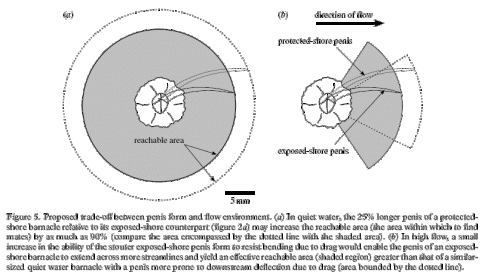![]()
“It’s only that short because I’ve been living in a location where I’m exposed to high turbulent flow”.
This might sound like a useful defence, but alas it is only valid if you happen to be a barnacle.
Today’s post is in honour of the birth of Charles Darwin, 199 years ago today. While you might be doubtful that an article about penises is appropriate for Darwin Day, I assure you it is; Mr Darwin spent a considerable amount of time studying barnacles (discovering numerous species and learning much about their biology) and I’m sure he’d be fascinated by the research outlined in this recent paper by Neufeld and Palmer (as he would be by the many advances in biology that have occurred since his time). Darwin even gets a name-check in the paper!
It’s a fairly well known pub-quiz-question fact that of all the animals on Earth, barnacles have the largest penises relative to their body size (click on the table below from the Neufeld and Palmer paper – the average human male would be less than 0.1 on that chart). Barnacles are hermaphrodites, so technically they could ‘self-fertilise’, however they apparently rarely or never do this. Therefore, since they can’t move around they need these long penises to be sure of finding reproductive mates – so the longer the better, you would think. However, there are likely to be certain technical challenges associated with oversized penises, such as storage and, of course, the rather unpleasant possibility of having it bitten off by some hungry fish.
One other factor is the potential difficulty of controlling the organ in situations with high turbulent flow, such as rocky shores exposed to strong wave action. Barnacle legs (yes, the feathery-looking appendages that barnacles extend out in order to filter food from the water column are, in fact, their legs) are known from previous work to differ in form between sheltered and exposed locations by way of adaptation to local conditions, so the authors hypothesized that similar constraints might affect penis length.
They found that they did. Barnacles in sheltered locations had generally longer penises, while those in more exposed conditions had generally shorter and thicker penises.
Such differentiation between populations in different conditions might occur via one of three mechanisms.
1) settling larvae select environments most suitable for their genotype (barnacles with ‘long’ penis genes settle preferentially in low-flow regimes)
2) larvae settle indiscriminately (with respect to the suitability of that location for their penis size) but those larvae less well adapted to those conditions suffer greater mortality (post-settlement mortality).
3) the characteristic in question is controlled more directly by environmental conditions – growth is flexible, and individuals grow different length penises depending on the environment they settle in – this is called ‘phenotypic plasticity’
The study looked at this in a second set of experiments. Settled barnacles transplanted from an exposed site to a sheltered one started to grow their penises significantly longer than those that were not transplanted. In the reverse experiment, barnacles transplanted from a sheltered to an exposed site showed less penis growth compared to those left alone in the sheltered site.
This is very strong evidence that we’re dealing with phenotypic plasticity – that the penis length is responding to environmental conditions rather than being simply determined by genes. Shorter, thicker penises are more controllable in conditions of high flow (and can be moved further against the flow) whereas in less hydrodynamically hostile conditions, penises are free to grow longer and range over a wider area (I wonder how long it will be until we start getting spam advertising new ‘low-turbulent flow’ pants in order to promote penis growth. It’s only a matter of time). In all situations then, penises will grow in such a way that the number of potential mates is optimised, as the figure below illustrates.
It seems plausible, then, that phenotypic plasticity in this characteristic is itself an adaptation to the barnacle lifestyle, which involves the possibility of settling in locations which can vary widely in their physical conditions.
But next time you’re passing an exposed rocky shore, spare a thought for those barnacles living there: they’re getting much less action than their cousins in more sheltered locations.
Neufeld, C.J., Palmer, A.R. (2008). Precisely proportioned: intertidal barnacles alter
penis form to suit coastal wave action. Proceedings of the Royal Society B: Biological Sciences DOI:10.1098/rspb.2007.1760


But maybe the…ok, forget it. I’m not even going to go there…
Interesting post. There was a Darwin Day celebration in Sacramento on Sunday with a speaker from the SETI (Search for Extra Terrestrial Intelligence) Institute. It was pretty interesting – not as weird as you might think. He also hosts a TV show that debunks such things as pseudo science, UFOs, and astrology.
By: Laurie on February 13, 2008
at 6:14 am